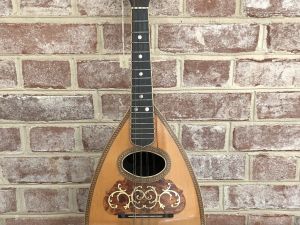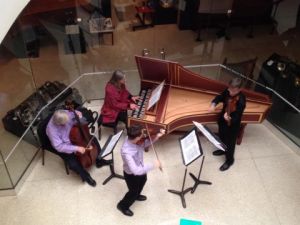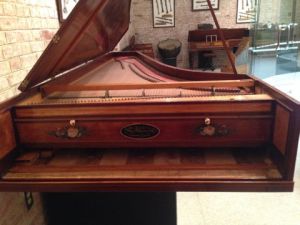Our Steinmeyer Portative Organ
One of the many instruments in DUMIC's collection is a small portative organ, made by Georg Steinmeyer in the early 1950s. John Santoianni, the Ethel Sieck Carrabina Curator of Organs and Harpsichords here at Duke, wrote the following post after examining the instrument as he prepared it for the Duke Collegium Musicum concert this past April.
This modern instrument reflects a style of small pipe organ which was used from medieval times to the 16th century. Typically, such examples had only one rank, or set, of pipes, and a single bellows on the back. Holding the organ perpendicular to oneself, the player would pump the bellows with the left hand and play the keyboard with the right. Smaller instruments could be held while played; this larger portative needs to sit on a table when being played.
This example has an internal bellows which feeds a small reservoir. This enables the organist to play continuously, rather than only having wind when a single bellows was being pumped. The player can operate the handle on the left, or a “calcant” or bellows pumper can be used, enabling the player to use both hands.
The two ranks of pipes are a Gedeckt and a Principal. A Gedeckt is a rectangular wooden pipe which is closed with a stopper and has a flute sound. A Principal is an open, metal flue pipe. This is the family of pipes one typically sees in an organ façade. This Principal has a brighter timbre, and sounds two octaves higher than the Gedeckt.
There are about two and a half octaves of keys, from tenor g to c’’’. With the Gedeckt rank playing, the lowest C on the keyboard will sound middle C.
It isn’t exactly clear when this instrument was built—perhaps in the 1950s. During the early 20th century, there was a nascent interest in performing early music on the instruments available when the music was written. This led to the restoration of old instruments as well as building replicas of existing ones.
The Steinmeyer name has been associated with Organbuilding since the middle of the 19th century. Georg Steinmeyer came to the U.S. in 1950 to work with the Estey Organ Company in Brattleboro, VT. In the mid 1950s, he worked with the well-known organist E. Power Biggs to record pipe organs in Austria, southern Germany, and eastern France that Mozart may have played.
The Collegium Musicum at Duke used this portative in their concert on Saturday, April 27th.




